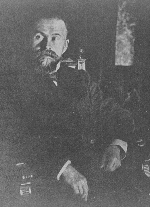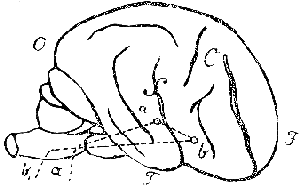DR. CARL WERNICKE
(1848-1904)
| Wernicke was born in Tarnovitz, Poland but his family moved to Germany where he received all his education. Interested in psychiatry, traditionally he studied anatomy initially and neuropathology later. He published a small volume on aphasia which vaulted him into international fame. In it was precise pathoanatomic analysis paralleling the clinical picture. He is best known for his work on sensory aphasia and poliomyelitis hemorrhagia superior. Both of these descriptions bear his name. Further, his books on the disorders of the internal capsule and his textbooks on diseases of the nervous system perpetuate him. |  |
 Wernicke's drawing of Motor and Sensory Speech areas |
Karl Wernicke (born 15 May 1848 in Tarnowitz, Silesia, Germany, died 15 June 1905 in Gräfenroda, Germany) was a German physician, anatomist, psychiatrist and neuropathologist.
Shortly after Paul Broca published his findings on language deficits caused by damage to what is now referred to as Broca's area, Wernicke began pursuing his own research into the effects of brain trauma on speech and language. Wernicke noticed that not all language deficits were the result of damage to Broca's area. Rather he found that damage to the left posterior, superior temporal gyrus resulted in deficits in language comprehension. This region is now referred to as Wernicke's area, and the associated syndrome is known as Wernicke's aphasia, for his discovery.